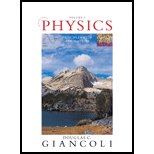
Concept explainers
A railroad car loaded with rocks coasts on a level track without friction. A worker at the back of the car starts throwing the rocks horizontally backward from the car. Then what happens?
- The car slows down.
- The car speeds up.
- First the car speeds up and then it slows down.
- The car's speed remains constant.
- None of these.
What happens to the speed of the railroad car, when a worker starts throwing rocks horizontally backward from the railroad car loaded with rocks.
Answer to Problem 1OQ
Solution:
The correct option is (B)The car speeds up.:
Explanation of Solution
Given:
The truck is loaded with rocks and is moving on a level track without friction.
The worker throws rocks horizontally in the backward direction.
The rock and the railroad car move forward with the same speed. Hence they have the same velocity with respect to ground and are at rest with respect to each other. In the system comprising of the railroad car and the stone, the total initial momentum of the car and the stone is zero.
When the stone is thrown backward, it acquires a velocity in the opposite direction to that of the car. The stone, thus has a momentum in the opposite direction to that of the car. Since, in an isolated system, momentum is conserved, the railroad car acquires an equal momentum in the forward direction. The speed of the car increases in the forward direction due to increase in its momentum. The car therefore speeds up.
Want to see more full solutions like this?
Chapter 7 Solutions
Physics
Additional Science Textbook Solutions
Campbell Essential Biology with Physiology (5th Edition)
Organic Chemistry (8th Edition)
Chemistry: An Introduction to General, Organic, and Biological Chemistry (13th Edition)
Human Anatomy & Physiology (2nd Edition)
Introductory Chemistry (6th Edition)
Campbell Biology (11th Edition)
- 8. With the aid of a diagram draw the following electric circuit and use the resistor as the load, (a) Closed circuit (b) Open circuitarrow_forwardLab 8 Part 3 PHET Wave Interface simulation. I am having trouble with this part of the lab.arrow_forwardMick and Rick are twins born on Earth in the year 2175. Rick grows up to be an Earth-bound robotics technician while Mick becomes an intergalactic astronaut. Mick leaves the Earth on his first space mission in the year 2200 and travels, according to his clock, for 10 years at a speed of 0.75c. Unfortunately, at this point in his journey, the structure of his ship undergoes mechanical breakdown and the ship explodes. How old is Rick when his brother dies?arrow_forward
 Glencoe Physics: Principles and Problems, Student...PhysicsISBN:9780078807213Author:Paul W. ZitzewitzPublisher:Glencoe/McGraw-Hill
Glencoe Physics: Principles and Problems, Student...PhysicsISBN:9780078807213Author:Paul W. ZitzewitzPublisher:Glencoe/McGraw-Hill Physics for Scientists and Engineers: Foundations...PhysicsISBN:9781133939146Author:Katz, Debora M.Publisher:Cengage Learning
Physics for Scientists and Engineers: Foundations...PhysicsISBN:9781133939146Author:Katz, Debora M.Publisher:Cengage Learning Physics for Scientists and Engineers, Technology ...PhysicsISBN:9781305116399Author:Raymond A. Serway, John W. JewettPublisher:Cengage Learning
Physics for Scientists and Engineers, Technology ...PhysicsISBN:9781305116399Author:Raymond A. Serway, John W. JewettPublisher:Cengage Learning Principles of Physics: A Calculus-Based TextPhysicsISBN:9781133104261Author:Raymond A. Serway, John W. JewettPublisher:Cengage Learning
Principles of Physics: A Calculus-Based TextPhysicsISBN:9781133104261Author:Raymond A. Serway, John W. JewettPublisher:Cengage Learning Physics for Scientists and Engineers with Modern ...PhysicsISBN:9781337553292Author:Raymond A. Serway, John W. JewettPublisher:Cengage Learning
Physics for Scientists and Engineers with Modern ...PhysicsISBN:9781337553292Author:Raymond A. Serway, John W. JewettPublisher:Cengage Learning Physics for Scientists and EngineersPhysicsISBN:9781337553278Author:Raymond A. Serway, John W. JewettPublisher:Cengage Learning
Physics for Scientists and EngineersPhysicsISBN:9781337553278Author:Raymond A. Serway, John W. JewettPublisher:Cengage Learning





